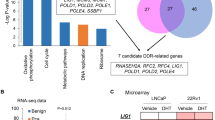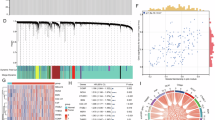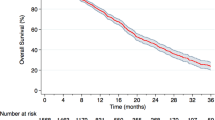Abstract
Background
Prostate cancer (PCa) is a heterogeneous disease affecting over 14% of the male population worldwide. Although patients often respond positively to initial treatments within the first 2–3 years, many eventually develop a more lethal form of the disease known as castration-resistant PCa (CRPC). At present, no biomarkers that predict the onset of CRPC are available. This study aims to provide insights into the diagnosis and prediction of CRPC emergence.
Methods
Protein expression dynamics were analysed in drug (androgen receptor inhibitor)-tolerant persister (DTP) and drug withdrawal cells using proteomics to identify potential biomarkers. These biomarkers were subsequently validated using a mouse model, 180-paired carcinoma/benign tissues, and 482 serum samples. Five machine learning algorithms were employed to build clinical prediction models, wherein the SHapley Additive exPlanation (SHAP) framework was used to interpret the best-performing model. Moreover, three regression models were developed to determine the Time from initial PCa diagnosis to CRPC development (TPC) in patients.
Results
We identified that the protein expression levels of GPX4, NDUFS4, PRDX5, and TXNRD2 were significantly upregulated in PCa patients, particularly in those with CRPC. Among the tested machine learning models, the random forest and extreme gradient boosting models performed best on tissue and serum cohorts, achieving AUCs of 0.958 and 0.988, respectively. In addition, a significant inverse correlation was observed between TPC and serum levels of these four biomarkers. This correlation was formulated in three regression models, which achieved the smallest mean absolute error of 1.903 on independent datasets for predicting CRPC emergence.
Conclusion
Our study provides new insights into the role of DTP cells in CRPC development. The quad protein panel identified in our study, along with the post hoc and intrinsically explainable prediction models, may serve as a convenient and real-time prognostic tool, addressing the current lack of clinical biomarkers for CRPC.

This is a preview of subscription content, access via your institution
Access options
Subscribe to this journal
Receive 24 print issues and online access
$259.00 per year
only $10.79 per issue
Buy this article
- Purchase on SpringerLink
- Instant access to full article PDF
Prices may be subject to local taxes which are calculated during checkout








Similar content being viewed by others
Data availability
All data supporting the findings of this study are available with the article, or from the corresponding author upon reasonable request. Data are also available via ProteomeXchange with the identifier PXD032983.
References
Huggins C, Hodeges CV. Studies on prostatic cancer. I. The effect of castration, of estrogen and androgen injection on serum phosphatases in metastatic carcinoma of the prostate. Cancer Res. 1941;1:293–7.
Cheng Q, Butler W, Zhou Y, Zhang H, Tang L, Perkinson K, et al. Pre-existing castration-resistant prostate cancer-like cells in primary prostate cancer promote resistance to hormonal therapy. Eur Urol. 2022;81:446–55.
Pienta KJ, Bradley D. Mechanisms underlying the development of androgen-independent prostate cancer. Clin Cancer Res. 2006;12:1665–71.
Wu MJ, Chen CJ, Lin TY, Liu YY, Tseng LL, Cheng ML, et al. Targeting KDM4B that coactivates c-Myc-regulated metabolism to suppress tumor growth in castration-resistant prostate cancer. Theranostics. 2021;11:7779–96.
Chowdhury S, Bjartell A, Agarwal N, Chung BH, Given RW, Pereira de Santana Gomes AJ, et al. Deep, rapid, and durable prostate-specific antigen decline with apalutamide plus androgen deprivation therapy is associated with longer survival and improved clinical outcomes in TITAN patients with metastatic castration-sensitive prostate cancer. Ann Oncol. 2023;34:477–85.
Ploussard G, Rozet F, Roubaud G, Stanbury T, Sargos P, Roupret M. Chromogranin A: a useful biomarker in castration-resistant prostate cancer. World J Urol. 2023;41:361–9.
Sharma SV, Lee DY, Li B, Quinlan MP, Takahashi F, Maheswaran S, et al. A chromatin-mediated reversible drug-tolerant state in cancer cell subpopulations. Cell. 2010;141:69–80.
Haven B, Heilig E, Donham C, Settles M, Vasilevsky N, Owen K. Registered report: a chromatin-mediated reversible drug-tolerant state in cancer cell subpopulations. eLife. 2016;5:69–80.
Boumahdi S, de Sauvage FJ. The great escape: tumour cell plasticity in resistance to targeted therapy. Nat Rev Drug Discov. 2020;19:39–56.
Wang R, Mi Y, Ni J, Wang Y, Ding L, Ran X, et al. Identification of PRDX5 as a target for the treatment of castration-resistant prostate cancer. Adv Sci. 2023. https://doi.org/10.1002/advs.202304939.
Fei X, Du X, Wang J, Liu J, Gong Y, Zhao Z, et al. Precise diagnosis and risk stratification of prostate cancer by comprehensive serum metabolic fingerprints: a prediction model study. Int J Surg. 2024. https://doi.org/10.1097/js9.0000000000001033.
Kour B, Shukla N, Bhargava H, Sharma D, Sharma A, Singh A, et al. Identification of plausible candidates in prostate cancer using integrated machine learning approaches. Curr Genomics. 2023;24:287–306.
Gabriele C, Aracri F, Prestagiacomo LE, Rota MA, Alba S, Tradigo G, et al. Development of a predictive model to distinguish prostate cancer from benign prostatic hyperplasia by integrating serum glycoproteomics and clinical variables. Clin Proteom. 2023;20:52.
Badmos S, Noriega-Landa E, Holbrook KL, Quaye GE, Su X, Gao Q, et al. Urinary volatile organic compounds in prostate cancer biopsy pathologic risk stratification using logistic regression and multivariate analysis models. Am J Cancer Res. 2024;14:192–209.
Lundberg S, Lee S-I. A unified approach to interpreting model predictions. In: 31st Conference on Neural Information Processing Systems (NIPS 2017). Long Beach, CA, USA; 2017. https://doi.org/10.48550/arXiv1705.07874.
Lundberg SM, Nair B, Vavilala MS, Horibe M, Eisses MJ, Adams T, et al. Explainable machine-learning predictions for the prevention of hypoxaemia during surgery. Nat Biomed Eng. 2018;2:749–60.
Ellwood-Yen K, Graeber TG, Wongvipat J, Iruela-Arispe ML, Zhang J, Matusik R, et al. Myc-driven murine prostate cancer shares molecular features with human prostate tumors. Cancer Cell. 2003;4:223–38.
Wang R, Wen P, Yang G, Feng Y, Mi Y, Wang X, et al. N-glycosylation of GDF15 abolishes its inhibitory effect on EGFR in AR inhibitor-resistant prostate cancer cells. Cell Death Dis. 2022;13:626.
Wang R, Mi Y, Ni J, Wang Y, Ding L, Ran X, et al. Identification of PRDX5 as a target for the treatment of castration-resistant prostate cancer. Adv Sci. 2024;11:e2304939.
Grasso CS, Wu YM, Robinson DR, Cao X, Dhanasekaran SM, Khan AP, et al. The mutational landscape of lethal castration-resistant prostate cancer. Nature. 2012;487:239–43.
Liberzon A, Birger C, Thorvaldsdóttir H, Ghandi M, Mesirov JP, Tamayo P, et al. The Molecular Signatures Database (MSigDB) hallmark gene set collection. Cell Syst. 2015;1:417–25.
Breiman L. Random forests. Mach Learn. 2001;45:5–32.
Ho TK. Random decision forests. In: Proceedings of 3rd International Conference on Document Analysis and Recognition. Montreal, QC, Canada: IEEE; 1995, p. 278–82. https://doi.org/10.1109/ICDAR.1995.598994.
Kattan MW, Eastham JA, Stapleton AM, Wheeler TM, Scardino PT. A preoperative nomogram for disease recurrence following radical prostatectomy for prostate cancer. J Natl Cancer Inst. 1998;90:766–71.
Stephenson AJ, Scardino PT, Eastham JA, Bianco FJ Jr, Dotan ZA, Fearn PA, et al. Preoperative nomogram predicting the 10-year probability of prostate cancer recurrence after radical prostatectomy. J Natl Cancer Inst. 2006;98:715–7.
Cooperberg MR, Broering JM, Carroll PR. Risk assessment for prostate cancer metastasis and mortality at the time of diagnosis. J Natl Cancer Inst. 2009;101:878–87.
Gleason DF. Classification of prostatic carcinomas. Cancer Chemother Rep. 1966;50:125–8.
Draisma G, Etzioni R, Tsodikov A, Mariotto A, Wever E, Gulati R, et al. Lead time and overdiagnosis in prostate-specific antigen screening: importance of methods and context. J Natl Cancer Inst. 2009;101:374–83.
Rebello RJ, Oing C, Knudsen KE, Loeb S, Johnson DC, Reiter RE, et al. Prostate cancer. Nat Rev Dis Prim. 2021;7:9.
Eggener SE, Rumble RB, Armstrong AJ, Morgan TM, Crispino T, Cornford P, et al. Molecular biomarkers in localized prostate cancer: ASCO guideline. J Clin Oncol. 2020;38:1474–94.
Lokeshwar SD, Syed JS, Segal D, Rahman SN, Sprenkle PC. Optimal use of tumor-based molecular assays for localized prostate cancer. Curr Oncol Rep. 2022;24:249–56.
Olleik G, Kassouf W, Aprikian A, Hu J, Vanhuyse M, Cury F, et al. Evaluation of new tests and interventions for prostate cancer management: a systematic review. J Natl Compr Cancer Netw. 2018;16:1340–51.
Bronimann S, Pradere B, Karakiewicz P, Abufaraj M, Briganti A, Shariat SF. An overview of current and emerging diagnostic, staging and prognostic markers for prostate cancer. Expert Rev Mol Diagn. 2020;20:841–50.
Visser WCH, de Jong H, Melchers WJG, Mulders PFA, Schalken JA. Commercialized blood-, urinary- and tissue-based biomarker tests for prostate cancer diagnosis and prognosis. Cancers. 2020;12:3790.
Dong M, Lih TM, Chen SY, Cho KC, Eguez RV, Hoti N, et al. Urinary glycoproteins associated with aggressive prostate cancer. Theranostics. 2020;10:11892–907.
Zhou L, Song Z, Hu J, Liu L, Hou Y, Zhang X, et al. ACSS3 represses prostate cancer progression through downregulating lipid droplet-associated protein PLIN3. Theranostics. 2021;11:841–60.
Han Q, Xie QR, Li F, Cheng Y, Wu T, Zhang Y, et al. Targeted inhibition of SIRT6 via engineered exosomes impairs tumorigenesis and metastasis in prostate cancer. Theranostics. 2021;11:6526–41.
Llop E, Ferrer-Batalle M, Barrabes S, Guerrero PE, Ramirez M, Saldova R, et al. Improvement of prostate cancer diagnosis by detecting PSA glycosylation-specific changes. Theranostics. 2016;6:1190–204.
Sfanos KS, Yegnasubramanian S, Nelson WG, De Marzo AM. The inflammatory microenvironment and microbiome in prostate cancer development. Nat Rev Urol. 2018;15:11–24.
Su X, Wang Z, Li J, Gao S, Fan Y, Wang K. Hypermethylation of the glutathione peroxidase 4 gene promoter is associated with the occurrence of immune tolerance phase in chronic hepatitis B. Virol J. 2024;21:72.
Liu J, An W, Zhao Q, Liu Z, Jiang Y, Li H, et al. Hyperbaric oxygen enhances X-ray induced ferroptosis in oral squamous cell carcinoma cells. Oral Dis. 2024;30:116–27.
Abbas SF, Abdulkadim H, Hadi NR. Assessing the cardioprotective effect of necrosulfonamide in doxorubicin-induced cardiotoxicity in mice. J Med Life. 2023;16:1468–73.
Uzawa A, Kawaguchi N, Kanai T, Himuro K, Oda F, Kuwabara S. Increased serum peroxiredoxin 5 levels in myasthenia gravis. J Neuroimmunol. 2015;287:16–18.
Mahmoudian E, Khalilnezhad A, Gharagozli K, Amani D. Thioredoxin-1, redox factor-1 and thioredoxin-interacting protein, mRNAs are differentially expressed in multiple sclerosis patients exposed and non-exposed to interferon and immunosuppressive treatments. Gene. 2017;634:29–36.
Lin W, Tang Y, Zhang M, Liang B, Wang M, Zha L, et al. Integrated bioinformatic analysis reveals TXNRD1 as a novel biomarker and potential therapeutic target in idiopathic pulmonary arterial hypertension. Front Med. 2022;9:894584.
Meplan C, Rohrmann S, Steinbrecher A, Schomburg L, Jansen E, Linseisen J, et al. Polymorphisms in thioredoxin reductase and selenoprotein K genes and selenium status modulate risk of prostate cancer. PLoS ONE. 2012;7:e48709.
Bendtsen JD, Jensen LJ, Blom N, Von Heijne G, Brunak S. Feature-based prediction of non-classical and leaderless protein secretion. Protein Eng Des Sel. 2004;17:349–56.
Gunther EC, Stone DJ, Gerwien RW, Bento P, Heyes MP. Prediction of clinical drug efficacy by classification of drug-induced genomic expression profiles in vitro. Proc Natl Acad Sci USA. 2003;100:9608–13.
Tong W, Xie Q, Hong H, Shi L, Fang H, Perkins R, et al. Using decision forest to classify prostate cancer samples on the basis of SELDI-TOF MS data: assessing chance correlation and prediction confidence. Environ Health Perspect. 2004;112:1622–7.
Ferrigno I, Verzellesi L, Ottone M, Bonacini M, Rossi A, Besutti G, et al. CCL18, CHI3L1, ANG2, IL-6 systemic levels are associated with the extent of lung damage and radiomic features in SARS-CoV-2 infection. Inflammation Res. 2024. https://doi.org/10.1007/s00011-024-01852-1.
Wu P, Zhang C, Tang X, Li D, Zhang G, Zi X, et al. Pan-cancer characterization of cell-free immune-related miRNA identified as a robust biomarker for cancer diagnosis. Mol Cancer. 2024;23:31.
Zhang Y, Ma Y, Wang J, Guan Q, Yu B. Construction and validation of a clinical prediction model for deep vein thrombosis in patients with digestive system tumors based on a machine learning. Am J Cancer Res. 2024;14:155–68.
Funding
This study was supported by the National Natural Science Foundation of China (No. 82403686 & 82370777 & 82302654 & 31771539); by the Basic Research Program of Jiangsu (No. BK20241620 & BK20230188); by the Singapore Ministry of Health’s National Medical Research Council (NMRC) Open Fund—Individual Research Grant (OF-IRG; to L-W Ding; MOH-OFIRG21nov-0007); by the China Postdoctoral Science Foundation (No. 2024M751160); by the Jiangsu Funding Program for Excellent Postdoctoral Talent (No. 2024ZB069); and by Medical Research Program of Affiliated Hospital of Jiangnan University (No. YJY202306).
Author information
Authors and Affiliations
Contributions
RW, SPW, NHF, YQC and LWD conceptualised the study, designed and performed experiments, developed and optimised methodology, curated data, analysed data and visualised data. YYM, TYH, JW and JN developed and optimised methodology, designed and performed experiments, curated data and visualised data. JY, MML and XBR developed and optimised methodology, analysed data and visualised data. SYF, QYS, SYT and HPK developed and optimised methodology. RW and SPW drafted the manuscript. SYT, HPK, RW, SPW, YQC and JW edited the manuscript. YQC, LWD, RW, MLL and NHF provided financial support. All authors read and approved the final manuscript.
Corresponding authors
Ethics declarations
Competing interests
The authors declare no competing interests.
Ethics approval and consent to participate
Patient tissue and peripheral blood samples were collected from the Affiliated Hospital of Jiangnan University. Informed consent was obtained from all participants included in this study according to ethical committee regulations (the Affiliated Hospital of Jiangnan University, approval document number: LS202128).
Consent for publication
All authors have agreed to publish this manuscript.
Additional information
Publisher’s note Springer Nature remains neutral with regard to jurisdictional claims in published maps and institutional affiliations.
Rights and permissions
Springer Nature or its licensor (e.g. a society or other partner) holds exclusive rights to this article under a publishing agreement with the author(s) or other rightsholder(s); author self-archiving of the accepted manuscript version of this article is solely governed by the terms of such publishing agreement and applicable law.
About this article
Cite this article
Wang, R., Wang, S., Mi, Y. et al. Elevated serum levels of GPX4, NDUFS4, PRDX5, and TXNRD2 as predictive biomarkers for castration resistance in prostate cancer patients: an exploratory study. Br J Cancer 132, 543–557 (2025). https://doi.org/10.1038/s41416-025-02947-0
Received:
Revised:
Accepted:
Published:
Issue date:
DOI: https://doi.org/10.1038/s41416-025-02947-0
This article is cited by
-
An exploratory study of new predictive biomarkers of castration resistance
Nature Reviews Urology (2025)



